 |
| |
| |
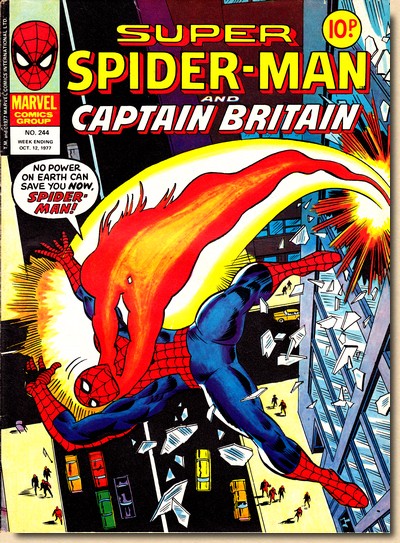 |
|
MARVEL UK
SUPER SPIDER-MAN
AND CAPTAIN BRITAIN
#244
(WEEK ENDING OCTOBER
12 1977)
Launched
in September 1972, Marvel's very own UK imprint
(commonly known and referred to as Marvel UK) enjoyed an immediate
success, producing a steadily growing number of
titles which reprinted US material following the
standard 1970s UK comic book market format of
weekly publication and black and white printing.
Following
up on the first (and flagship) title Mighty World of Marvel, the most successful and
best loved superhero from the House of Ideas, the
Amazing Spider-Man, was given his own weekly
title in February 1973: Spider-Man
Comics Weekly.
|
|
| |
| It would
ultimately become one of the longest running UK Marvel
comic books ever, clocking up an impressive 666 issues
over a 12 year publication run up until 1985 - a fact
somewhat obscured by no less than 10 title changes along
the way. The first of these occured in February 1976 when
Spider-Man Comics Weekly became Super
Spider-Man with the Super-Heroes as of issue #158 -
essentially the result of merging the successful Spider-Man
Comics Weekly with the somewhat less successful
weekly Super-Heroes, which had been launched in
March 1975. With the British economy sliding into deep
recession in 1976, such mergers and the
resulting composite titles almost became a
trademark survival strategy for Marvel UK's weeklies as
they braved the harsh market conditions of the mid-1970s.
Super Spider-Man
with the Super-Heroes became Super
Spider-Man and the Titans in October 1976, before the cancellation of
Captain Britain's own weekly changed its title to Super
Spider-Man & Captain Britain in July 1977. So let's thumb
through the 36 pages of Super Spider-Man and Captain
Britain #244, which went on sale the week ending
October 12th 1977.
|
| |
|
| |
AMAZING
SPIDER-MAN
"Enter:
Will-O'-The-Wisp!"
Originally published in Amazing
Spider-Man #167 (April 1977)
Original title: "...Stalked
by the Spider-Slayer!"
Script - Len Wein
Pencils - Ross Andru
(breakdowns), Mike Esposito
(finished art)
Inks - Mike Esposito
Lettering - Joe Rosen
Original
page count: 17
Reprinted pages: 8 (plus UK splashpage)
Ever
since the launch of Marvel UK, readers were used
to having several characters and storylines
feature in one title. As a consequence, the
individual installments per issue could be as
short as five or six pages, but the weekly
publication schedule didn't really make the
stories any harder to follow than e.g. with the
monthly pause between two US originals. By 1977,
the segmentation this created commonly resulted
in an original issue of Amazing Spider-Man
being more or less halved and published over two
UK issues - which in return required a custom
made splashpage for every other issue of Super
Spider-Man and Captain Britain, which was also the case for
this issue.
During
the early years of Marvel UK these extra
splashpages (which often also served to bring
readers back up to speed as to "the story so
far") were often made simply by blowing up a
single panel from the final page published in the
previous issue and adding a title, creators
credits and exposition text or additional word
balloons. Since the mid-1970s, however, these
extra splashpages were being produced from
scratch by various artists, although the artwork
in many cases remained inspired by the original
panel artwork used in the preceding issue. The
splashpage of Super Spider-Man and
Captain Britain #244 is such an example,
where the setup of last week's penultimate panel
was used and Spider-Man's posture almost (but not
quite) swiped while the Spider-Slayer was
portrayed more prominently (thus also serving to
get readers back into the overall storyline). A number of artists working
out of the New York City offices of Marvel Comics
were involved in this production and regularly
assigned to the House of Ideas' "British
Department":
|
|
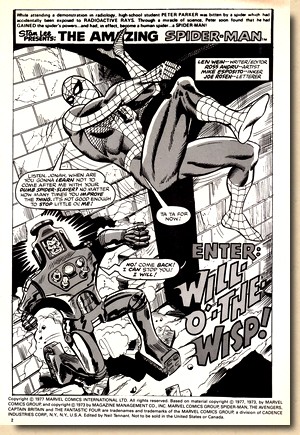
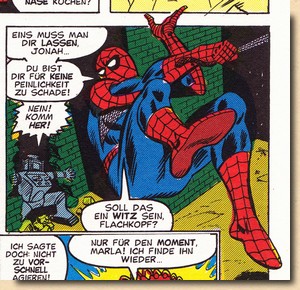
Amazing Spider-Man
#167
(German reprint version, 2006)
|
|
| |
"Larrupin'
Larry Lieber (...) has also come aboard to handle the
issues which we produce for an ever-growing army of
Marvel fanatics in Great Britain. Wouldja believe
they're on sale weekly over
there; so we're bettin' that Larry'll be kinda
busy." (Stan's Soapbox,
September 1977 Bullpen Bulletins, Marvel [US] Comics)
Stan Lee's brother had, in
fact, already been quite busy for Marvel UK before taking
on the job as editor, often pencilling covers and
other material together with Frank Giacoia.
|
| |
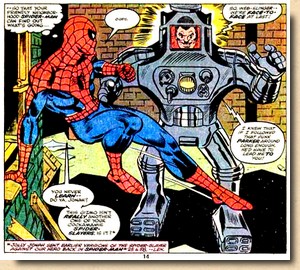
Amazing
Spider-Man #167
|
|
The splashpage produced for Super
Spider-Man and Captain Britain #244 thus
precedes pages
10-17 of Amazing Spider-Man
#167, the story of which centers around yet
another incarnation of J. Jonah Jameson's
"Spider-Slayer" robot. The publisher and
editor-in-chief of the Daily Bugle (and number
one hater of Spider-Man) first had a robot built
for himself in Amazing Spider-Man #25
(June 1965) in order to try to hunt down and
capture the friendly neighbourhood webcrawler via
remote control.
The Spider-Slayer
featured in Amazing Spider-Man
#167 was already the Mark V, which unlike previous models was
controlled through mental commands transmitted
through a special helmet worn by Jameson. As a
result, Spider-Man findes that this version of
the Slayer not only has far better reaction times
than previous models but that he is also up
against super-strength, a web-shooter, plus a
laser-cannon shooting "impulse beams".
|
|
| |
| But even more threatening
is Jameson's talk about having bulletproof evidence as to
who exactly Spider-Man is - something Peter Parker /
Spider-Man simply can't ignore. However, trying to get to
the bottom of this and then dig up and get hold of this
information which Jameson supposedly has, Spidey runs
across the strange density manipulating powers of
Will-o'-the-Wisp. |
| |
| A
former employee at Roxxon Oil, Jackson
Arvad worked as a scientist in the
company's electromagnetic research
division. Forced to devote more hours to
his work than is healthy by a grueling
boss, Arvad eventually ended up falling
asleep, and a subsequent accident in the
laboratory exposed him to the
electromagnetic field of a device he was
working on. As a result, the
electromagnetic binding of molecules in
his body decreased and Arvad found he was
now able to actually control this
process, empowering him to change his
body matter from anything between
intangible or rock hard. At higher
densities, Will-o'-the-Wisp has
superhuman strength, speed and
durability, while at lower densities he
can fly. This is when he appears to be
nothing more than a glowing sphere. One
important power is his ability to
virtually "freeze up" people
for a short period of time.
Created by
Len Wein and Ross Andru together with
Mike Esposito, Amazing Spider-Man
#167 was the first appearance of Will-o'-the-Wisp
- a term made up from "wisp"
(i.e. a bundle of sticks or paper
sometimes used as a torch) and the name
"Will". The expression has a
smilar meaning to Jack-o'-Lantern
("Jack of [the] lantern") and
was frequentlly used until the late 19th
century to describe an atmospheric
"ghost light" seen by
travellers at night, especially over
bogs, swamps or marshes. It resembles a
flickering lamp and is said to recede if
approached, drawing travellers from the
safe paths (the scientific explanation
for the phenomenon lies in the decay of
organic matter which can set free methane
and phosphane which can spontaneously
ignite on contact with the oxygen in
air).
So at the
end of this story, Spider-Man finds
himself between a rock and a hard place
as he is mesmerized by Will-o'-the-Whisp
just as Jameson's Spider-Slayer re-enters
the scene...
As the final
page reprinted in Super Spider-Man
and Captain Britain #244 was also
the last page of Amazing Spider-Man
#167, no editorial adjustements were
necessary as the page could simply be
reprinted one to one (quite unlike, of
course, any non-English language
reprints, such as the example shown here
from a 2006 German reprint version).
Spider-Man
was just as popular in the UK as he was
in the US at the time, but this
popularity proved to be a two-edged sword
for Marvel UK. On the one hand, it meant
solid sales for any comic book that had Spider-Man
in its title. On the other hand it also
meant that Marvel UK had to start
thinking hard about where it would get
sufficient original Spidey material from.
The problem
really was quite simple: the weekly
publication schedule meant that Super Spider-Man
and Captain Britain was catching up with
the original material at a fairly
consistent rate of two to one each month,
i.e. reprinting two entire issues of the
monthly US Amazing Spider-Man
every month.
|
|
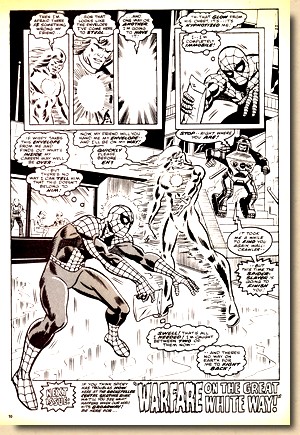
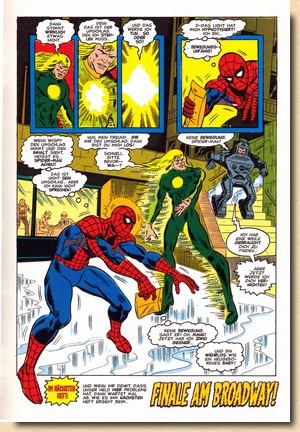
|
|
|
| |
| When Super
Spider-Man and Captain Britain #244 was published,
the gap had narrowed down dangerously to a mere nine
months (Amazing
Spider-Man #167 had a cover date of April 1977
but was actually published in the US in January 1977). In
the past, Marvel UK had counteracted this by reprinting
material from Peter Parker Spectacular Spider-Man
as well as Marvel Team-Up, but the overall
situation remained uncomfortable and no doubt a constant
source of headaches for the editorial team. |
| |
|
| |

CAPTAIN BRITAIN
"Dogfight
with Death!"
Original publication
(Super Spider-Man & Captain Britain
#244 - October 1977)
Script - Jim Lawrence
Pencils - Ron Wilson
Inks - Fred Kida
Lettering - Irv Wattanabe
Editor - Larry Lieber
Page
count: 7
Inspite
of the frequent custom-made covers and splash
pages that featured in its weeklies, Marvel UK
was all about reprinting US material. However,
there were a few exceptions here and there, and Captain
Britain was certainly the most important and
to this day best known original Marvel creation
for the British market.
|
|
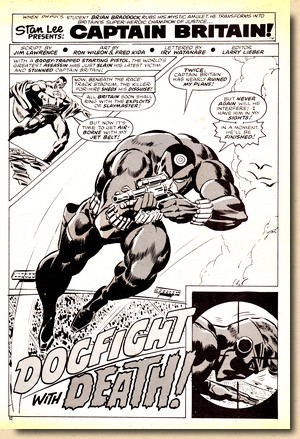
|
|
| |
| The launch took place after
the powers
in charge at the House of Ideas had reached the
conclusion that the time was right for some original
content within Marvel UK's line and turned out a
character whose name said it all - with more than obvious
parallelisms to Captain America. |
| |
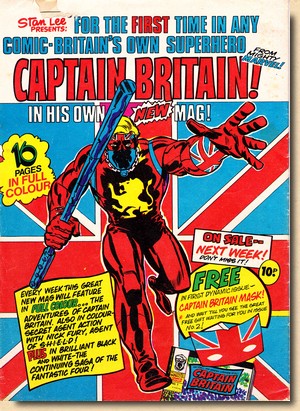
Back
cover advertising for Captain Britain #1
from Mighty World of
Marvel #210
|
|
Captain Britain #1
hit the newsagent stands on 13 October 1976 ("for the first time
in any comic - Britain's own superhero"), featuring
an eight page colour story titled "The
origin of Captain Britain" penned by
Chris Claremont, drawn by Herb Trimpe, inked by
Fred Kida, and - yes indeed - coloured by Marie
Severin. The editorial shout-outs just prior to
the launch were highly enthusiastic to say the
least:
"Next
week is it, folks! (...) the week of the
newest, greatest sensation from the fabulous
House of Ideas, Captain
Britain!! We've hinted at
it over the past few weeks, but we've not
even come close to the excitement that awaits
you in the latest, greatest British Weekly!!
Not only do we have a brand-new,
never-before-seen feature in the book (namely
one Captain Britain), but we also have -
colour (...) 'cause we want ya to get the
full impact of this new Claremont / Trimpe /
Kida creation!"
Colour
had been a wish expressed in many fan letters
ever since Marvel UK launched its first weeklies,
and it would initially secure good sales figures
for Captain Britain. However, the
novelty attraction wore off fairly soon as the
overall quality of the CB material left many
readers rather disappointed, and as a consequence
the title lost its (expensive) privilege to
colour as of issue #24 in March 1977 and would be
cancelled after just 39 weekly issues in July
1977.
|
|
| |
| This was
partly due to the fact that the main artistic team of
this first original British Marvel material had a rather
low-level linkage to the UK (Chris Claremont was a US
citizen born in London, and Herb Trimpe had once spent a
holiday in Britain). Although they tried hard to infuse
as much Britishness as possible into the title (including
British spelling variants being observed), many fairly
obvious mistakes could be spotted e.g. in British police
uniform design or the City of London's general geography.
At the end of the day, Captain Britain was thus a purely
American view of what a British superhero should look and
be like, and unfortunately, the individual artists
involved were unable to connect to this foreign setting
and plot enough to make it work. Claremont continued
to script the adventures of Captain Britain for the first
ten issues before Gary Friedrich took over with Captain
Britain #11 (22 December 1976), joined by Larry
Lieber as co-writer as of issue #24. Friedrich quit after
Captain Britain #36 (15 June 1977), and left
Lieber, Bob Budiansky and Jim Lawrence to pen the final
three issues before the title was cancelled. The artwork
was entrusted to Trimpe before John Buscema took over
together with inker Tom Palmer as of Captain Britain #24
(23 March 1977) before passing on the job to Ron Wilson
with issue #31 (11 May 1977), inked by Fred Kida, Pablo
Marcos and Brian Moore.
|
| |
| In spite of a few nice
touches (such as having real-life Prime Minister
James Callaghan being informed by Nick Fury of a
Nazi plan by the Red Skull to take over Great
Britain in Captain Britain #17) both the
plot and the artwork of Captain Britain
generally seem rather lacklustre and lukewarm
with very little to spark real enthusiasm amongst
readers - which hardly comes as a surprise
considering Herb Trimpe's point of view expressed
in an interview ("I thought [Captain
Britain] was a really stupid idea, but there was
a paycheck in it..."). Following the
cancellation of his own book, Captain Britain was
moved to the Spider-Man weekly (which accordingly
became Super Spider-Man and
Captain Britain) where he continued to act
out mostly ludicrous plots and storylines - of
which "Dogfight with Death!" is a case
in point.
|
|
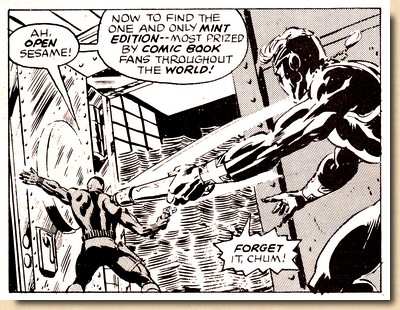 |
|
| |
| When Captain Britain faces
the evil Slaymaster he discovers that this villain is
stealing valuable collectables from a number of victims,
and tracks him down to comic collector Waxman's "Wax
Museum of Superheroes" where Slaymaster has just
murdered Waxman while in the guise of a wax copy of
"Electro-Man". |
| |
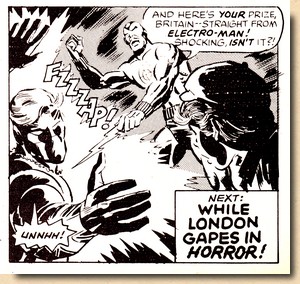 |
|
Much as readers may have been
able to relate to the villain's booty ("most
prized by comic book fans throughout the
world"), seeing him standing in front
of a strongroom with a massive pile of comic
books inside while proclaiming "now to
find the one and only mint edition"
must have made them wondering just how much time
the criminal had reckoned he would have to spend
until he actually found what he came to steal...
but then the question was of an academic nature,
as Captain Britain (who is physics student Brian
Braddock when he is off-duty) bursts onto the
scene - only to be disarmed immediately before
the cliffhanger ending for this issue.
It was
possibly the fact that these seven page
installments were written as such (and not cut-up
segments of a longer original storyline) which
generally made them feel very rushed and
disconnected. Ron Wilson's pencils often were the
only thread that kept it all from falling apart -
which, nevertheless, it ultimately did.
|
|
| |
| After
lasting a mere 22 issues, Super Spider-Man and Captain
Britain #253 brought about the final end of Captain
Britain in December 1977. The weekly went back to being
simply Super Spider-Man, and Britain's very own
superhero would not be seen for some time. |
| |
|
| |
THE
MIGHTY AVENGERS
"The Swordman's Secret!"
Originally published in Mighty
Avengers #121 (March 1974)
Original title: "Houses
Divided Cannot Stand!"
Script - Steve
Englehart
Pencils - John Buscema (layouts),
Done Heck (finished art)
Inks - Don Heck
Lettering - John Costanza
Total
page count: 19
Reprinted pages: 8 (plus UK splashpage)
The Mighty Avengers were
introduced to the ranks of Marvel UK in August
1973 in the pages of Mighty World of Marvel #46,
starting out with the classic Stan Lee & Jack
Kirby origin tale from Avengers #1, and
almost immediately moved on to their own weekly
title in September 1973. But as the British comic book
market was hit hard by the failing UK economy in
the mid-1970s, even Earth's Mightiest Heroes
became victims of Marvel UK's pruning and
downsizing of its portfolio of weeklies - and as
a result lost their own title in July 1976 after
148 issues and found themselves back where they
had started: in the pages of Mighty World of
Marvel.
|
|
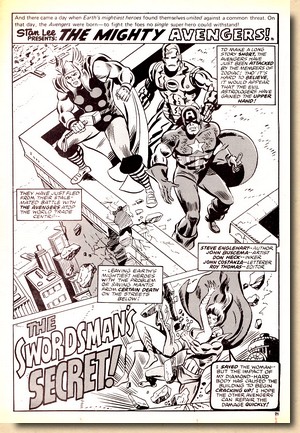
|
|
| |
| This
arrangement, however, was not to last very long, as the
Avengers only guest-starred for 13 issues of Mighty
World of Marvel before being transferred to the
pages of The Titans, which itself would merge
with Spidey's weekly and become Super Spider-Man and
the Titans in December 1976. |
| |
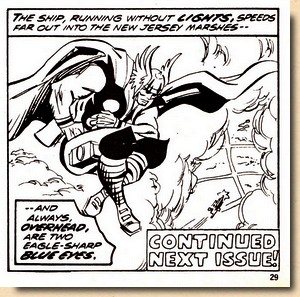 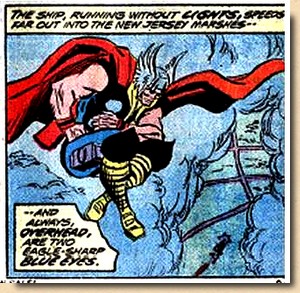
|
|
One merger later, the weekly
which hosted the Avengers became Super
Spider-Man and Captain Britain, illustrating
just how thin the line between enjoyable
diversity and chaotic discontinuity in Marvel
UK's weeklies had become by mid-1977. On the up
side, however, editorial always did an excellent
job in ensuring that the continuity of a series
was picked up exactly where it had left off prior
to a change of title due to cancellation or
mergers. The Avengers always had a
solid fan base amongst Marvel UK's 1970's
readership, but they never quite reached the
level of popularity enjoyed by Spider-Man and the
Hulk. As a result, they always survived the cut
& paste strategy of Marvel UK's numerous
cancellations and mergers of weekly titles but
tended to be moved around often.
Unfortunately,
as their weekly page count decreased from once
being a full US issue reprint (in the early
issues of their own title) to an average of
around 6-8 pages, the complexity of their
storylines increased as Roy Thomas and
subsequently Steve Englehart had truly probed the
group dynamics of the Avengers and set them up
against opponents which were far removed from the
simple superhero versus supervillain template.
"The
Swordman's Secret" is a point in case. It
reprints pages 9 through 16 of Mighty Avengers #121,
which in itself was only part two of a
three-issue story arc which has the Zodiac crime cartel
attempting to take over the world. The Avengers
manage to fight off the Zodiac's initial attack
on Avengers Mansion, but the conflict rages on
and the upper hand keeps on changing sides. Even
though not a hugely intricate plot to follow, the
serialisation over weekly installments of 8 or so
pages could at times make stories such as this
one a tad hard to follow. In comparison, pushing
the pause button (i.e. somewhere in the page
count of an original US issue) was a piece of
cake for Marvel UK editorial as they would simply
insert a text box at the bottom of the original
panel reading "CONTINUED NEXT ISSUE!",
even though this did sometimes call for some
minor modification, as can be seen in this
example, where the Zodiac starship had to be
moved upwards so it would not be covered by the
editorial textbox.
|
|
| |
| "The
Swordman's Secret" presented entirely new material
for UK readers, as Mighty Avengers #121 was the
first US Avengers issue which had not been distributed to the UK
in early 1974
as part
of the British pence price
cover
print run destined for export to the UK. |
| |
|
| |
THE
FANTASTIC FOUR
"Together Again for the First Time!"
Originally published in Fantastic Four #132 (March
1973)
Script - Roy Thomas
Pencils - John Buscema
Inks - Joe Sinnott
Lettering - John Costanza
Total
page count: 20
Reprinted pages: 4 (plus UK splashpage)
Original title: "Omega the Ultimate
Enemy"
The
oldest material featured in Super
Spider-Man and Captain Britain #244 was also
its shortest installment. At a mere four pages,
the wrap-up to the original story from Fantastic Four #132 from March 1973, in
which Medusa
gets an FF uniform, the Torch changes from blue
to red costume (an effect somewhat lost in Marvel
UK's black & white reprint), and Crystal
snubs the Torch for Quicksilver, almost had the
quality of an epilogue. But then again, this was
exactly what it was, as this was to be the final
appearance of Mr Fantastic, the Invisible Girl,
the Human Torch and the Thing in the pages of the
Super
Spider-Man and Captain Britain weekly.
The Fantastic Four in many
ways shared the status and fate of the Avengers
during Marvel UK's 1970's reprint run. Although
featured in the line-up right from the beginning
(Mighty World of Marvel #1, September
1972), British readers somehow never warmed up to
Marvel's original team of superheroes the way
they did with Spider-Man and the Hulk. Although
popular up to a certain point, the Fantastic Four
had not seen a transfer to their own title book
up until October 1977. Instead, they had been
moved to The
Titans as of issue #27 in March
1976 before featuring as a black & white
back-up in Captain Britain as of the
first issue (October 1976). When that weekly was
cancelled in July 1977 the Fantastic Four joined
Captain Britain in his move to the newly merged Super
Spider-Man and Captain Britain weekly.
Although they had enjoyed
star billing on several covers (mostly so during
their run in The Titans), they had never
truly been a front row feature. However, that was
about to change, as readers would discover at the
end of those mere four pages of story - which
were introduced by a splashpage which illustrates
nicely how Marvel staff artists in New York
turned to the original material (in this case a
story panel from Fantastic
Four #132) for inspiration but never
produced a 1:1 swipe.
|
|
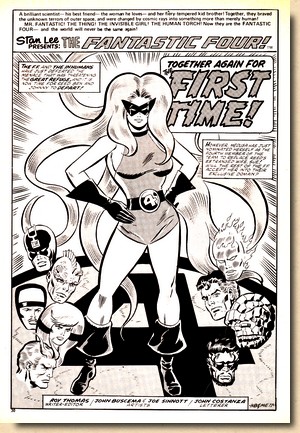
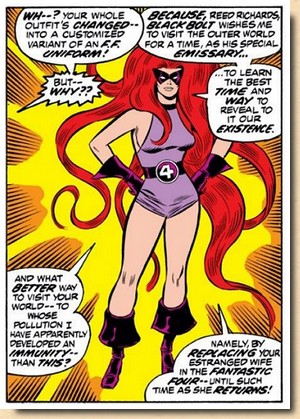
|
|
| |
| The added embellishment is
what often made the UK reprint material stand out and
which was to a large extent responsible for the charm of
the weeklies which even worked on seasoned readers who
knew the original material. This particular splashpage,
however, is special in a very different sense. The
aforementioned staff artists very rarely signed their
work, and the almost complete absence of such markings
makes it seem likely that Marvel in NYC had a policy in
place to that effect. If that was the case, then the FF
splashpage for Super Spider-Man and Captain
Britain #244 somehow slipped through as it has ·HB&ME77· marked next to the
credits. |
| |
 |
| |
The initials stand for
Howard Bender and Mike Esposito. Bender (*1951) worked as
penciller, inker, colourist and letterer for both Marvel
and DC in the 1970s, with most of his work for Marvel UK
being as penciller for the Star Wars weekly as
well as providing splashpages for some superhero
weeklies. Esposito (1927 - 2010) was a prolific comic
book artist best known for his inking on major Marvel and
DC titles throughout the Silver and Bronze Age; he became
involved in artwork produced for Marvel UK very early on
and received editorial shout-outs now and then:
"Adorable
ED HANNIGAN and Mischievous MIKE ESPOSITO, long time
workers on these books, have been teaming up on
covers drawn especially for the British editions of
THE PLANET OF THE APES!" (Bullpen
Bulletin published in The Avengers (UK) #61,
16 November 1974)
Turning to
the last of the four pages of the FF installment, readers
found out that the next issue of Super Spider-Man and
Captain Britain would feature the Mighty Thor rather
than the team from the Baxter Building. So which weekly
would the FF be moved to?
Somewhat
surprisingly (given the succession of cancellations and
mergers over the previous 12 months), Marvel UK was
adding a new weekly to its fold - and the FF finally made
it to their own title. The Complete Fantastic Four
(which first appeared at newsagents on 28 September 1977
and thus displayed some publication overlap, given that Super
Spider-Man and Captain Britain #244 was published
the week ending 12 October 1977) may have had a slightly
strange ring to its title, but the "Complete"
referred to the fact that, quite unlike the established
formula for Marvel's British reprints, this weekly
contained only FF material.
|
| |
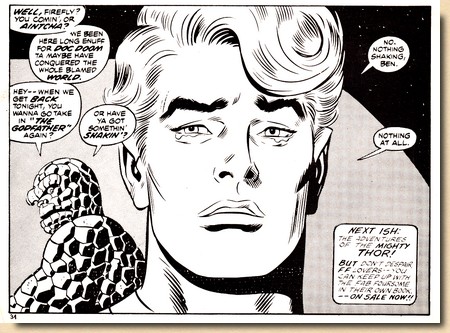 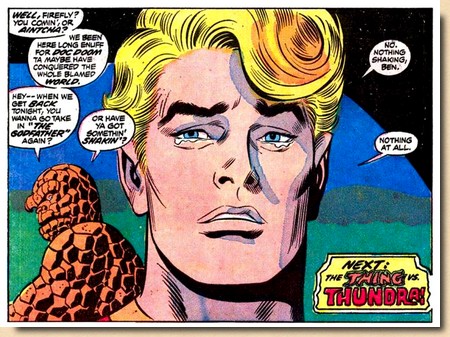
|
|
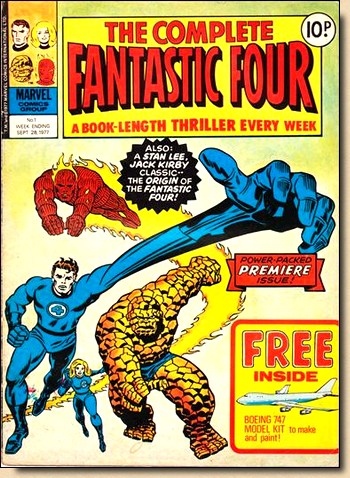
Complete Fantastic Four #1 (28 September
1977)
Complete
Fantastic Four #1 featured the reprint of
the entire US Fantastic Four #133 (April
1973) and a part of US Fantastic Four #1
(November 1961), and the following issues would
continue from here with complete issue reprints
of the more recent material (i.e. Fantastic
Four #134 in Complete Fantastic Four #2)
and serialized installments over three issues
from the classic Silver Age FF books (i.e. Fantastic
Four #1 spread out over Complete
Fantastic Four #1-3).
|
|
| |
| The
alteration necessary to the original final panel from Fantastic Four #132 in order
to fit the announcement was a straightforward and easy
task. The comparison, however, also shows how very often
the black and white reprint would come out rather
"flat"; originally, greytones had been added to
the Marvel UK material to counteract this effect, but the
process obviously became too tedious and, above all, too
costly. As for the Fantastic Four, the
pressure on the superhero weeklies remained high, and the
almost inevitable cancellation took place in June 1978
when Complete Fantastic Four ceased to appear at
the newsagents after 37 issues - to a large part also a
victim of its publication formula which, due to full US
issue length reprints, ate up over three years of US
publication output in less than a year alone.
The
Fantastic Four were duly transferred back to Mighty
World of Marvel as of issue #298 (14 June 1978) in
the established tradition of previous mergers and
cancellations, and when the end of an era came about and
Marvel UK's flagship title Mighty World of Marvel
was itself cancelled following issue #329 in January
1979, the FF once again moved - this time to Spider-Man
Comic #311 (24 January 1979).
|
| |
|
| |
| In 1977, Neil Tennant
(*1954) was still editor-in-chief of the British wing of
Marvel UK, having joined in 1975 and "not
earning very much money" [1],
which may have been the reason for him to soon leave his
post after Super Spider-Man and Captain
Britain #244 - and to ultimately find fame and, most
certainly, more money than he earned at Marvel UK as one
of the two Pet Shop Boys. |
| |
|
| |
| Marvel UK had always
operated out of London (first based at 120 Newgate Street
EC1 and then, as of late 1974, at 52 High Holborn WC1)
but in December 1976 moved to Tubs Hill House in
Sevenoaks, Kent. In true Stan Lee style, the various
editorial announcements made on this topic were picture
book hyperbole ("no longer does the British
bullpen battle brilliantly in London's High Holborn ...
will Sevenoaks survive?") but never really gave
an actual explanation or reason for the move - which, it
is to be assumed, were of a purely financial nature. Super Spider-Man
and Captain Britain #244 featured one page of
letters thus sent to Sevenoaks by readers, and as usual,
the topics touched upon were rather varied and diverse.
Whilst one reader was enquiring about the requirements
needed to be met in order to qualify as a KOF
("Keeper of the Flame"), another informed
editorial (and hence also all readers of this issue)
about Marvel merchandise toys available in the shops, and
a third claimed a "No-Prize" (which he got) for
having spotted an editorial blunder. Perhaps most
interesting, however, is the fourth letter, in which Paul
Ollis from Bristol voiced his opinion that Marvel UK
could very well print an entire US Spider-Man issue each
week as there were so many titles in the US featuring the
friendly neighbourhood webcrawler.
Editorial
pointed out ("we wish you were right, Paul, but
unfortunately you're not") that some of the
titles listed were either aimed at very young kids (Spidey
Super Stories) or itself a reprint title (Marvel
Tales), and that others had already been
exhaustively used (Marvel Team-Up).
The real
problem, of course, pointed in the exact opposite
direction - if anything, Marvel UK needed to reprint less.
The situation was
obvious to those who understood the American comic book
market: if you have eighteen to twenty original pages a
month and you reprint those on a weekly basis, you are
going to catch up with the original material at an
alarming speed, and reprinting entire issues (as in the
first year of Spider-Man Weekly and then for a
while in Super Spider-Man
with the Super-Heroes) only meant that
Marvel UK would catch up with and then run out of
original material fast.
Another subject brought up
regularly by readers was the demand for colour. While
this obviously was no option for the weeklies, annuals
could satisfy that request by featuring "62
pages in full colour". The three 1978 annuals
advertised here were published for Marvel UK by Fleetway
(a joint venture first undertaken in 1977 and which would
be replicated once more, in 1979).
|
| |
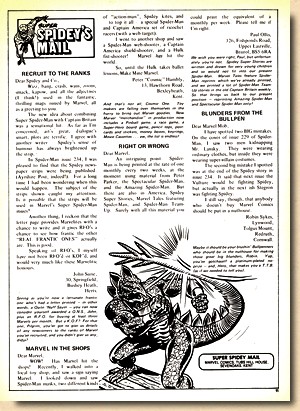 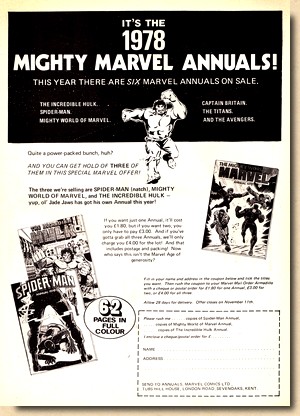 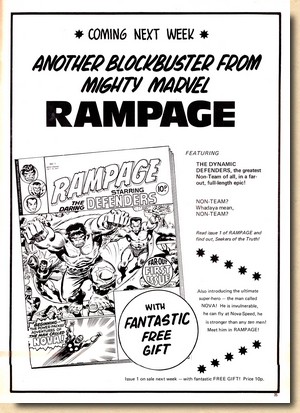 |
| |
| And if Complete
Fantastic Four had been a surprise, then how about
another new weekly being launched by Marvel UK? Rampage
#1 hit the newsagent stands on 19 October 1977,
and its subtitle explained to a large extent what
the new book was all about: "starring
the Daring Defenders" - plus "the
power-packed adventures of the man called
Nova". |
|
| |
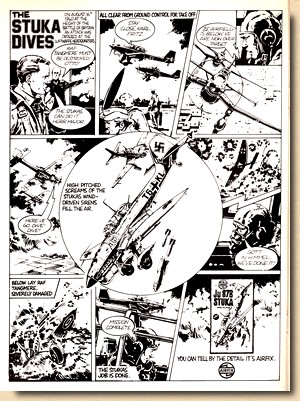 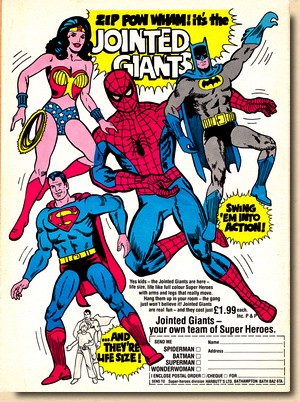
|
|
Taking up the same publishing
format launched with Complete Fantastic Four,
Rampage featured the reprint of a
complete US Defenders issue every week
(whilst Nova remained serialized). The book was
aimed outright at cashing in further on the
popularity of the Hulk, which was on a par with
the success enjoyed in Britain by Spider-Man,
whilst at the same time re-introducing well known
and liked characters such as Dr Strange and the
Sub-Mariner as members of this
"non-team". Rampage was
only a minor success, lasting for 34 issues
before being cancelled, again together with Complete
Fantastic Four, in June 1978. In contrast to
the usual Marvel UK tradition of merging and
swapping features around, however, the title
reappeared immediately as a monthly magazine - Rampage
Monthly - in July 1978.
Just
like Marvel's US range of magazine-format black
and white publications, the painted covers of Rampage
Monthly promised content aimed at a more
adult readership - in the case of Rampage
Monthly, however, the covers belied the
contents, which continued the reprints from the
weekly with the Defenders and Nova (a character
specifically aimed at pre-teen readers) as
backups.
Super
Spider-Man and Captain Britain #244 featured
two third-party adverts, one being the almost
traditional comic strip format for a plastic kit
(in this case from the classic brand of Airfix)
of a Ju87b "Stuka" - which followed the
long standing but still hugely popular war comics
such as Commando or Battle Picture
Library to a T: the German pilots of the
Stuka bombers were named Otto, Karl and Fritz,
exclaiming "Ze airfield is down below,
ve are now over target" and muttering
the par for the course (but grammatically
incorrect) "Gott in Himmel".
The Airfix ad may have shown them lay waste to
RAF Tangmere, but readers knew beyond a doubt
that these sky bandits would ultimately meet
their fate in the crosshairs of a few Spitfires -
also, naturally, available from Airfix.
The
other advertiser (whose ad was printed in lush
colours on the outside back cover) was a company
selling "life size" superhero figures
(of which three were actually of DC vintage).
The
front cover - also in glorious colour and often
serving as an advertisement board for the comic -
takes up one element from the cover of Amazing
Spider-Man #167 which John Romita Sr.
designed with three distinct elements.
|
|
| |
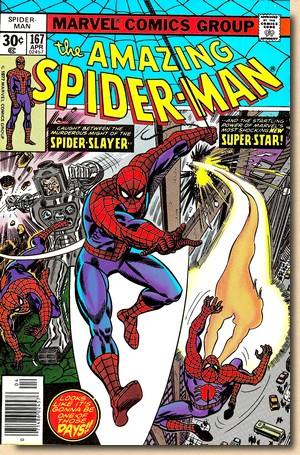 |
|
Again, it is easy to see how
the assigned staff artists would often work from
existing original artwork but rather produce a
new interpretation rather than just a clean swipe
or even a photostat. The result is
a cover just as interesting and as vibrant as the
original - which worked so well it was used by
various international publishers, e.g. from left
to right below:
- Panini
(German edition, Amazing Spider-Man
#167, 2006)
- Editoriale
Corno (Italian edition, L'uomo Ragno
#234, 1979)
- Novedades
(Spanish edition for Mexico, El
Asombroso Hombre Araña #163, 1983)
|
|
 |
|
| |
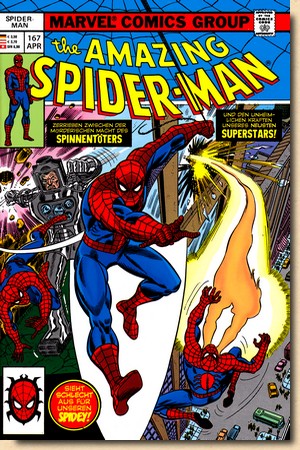 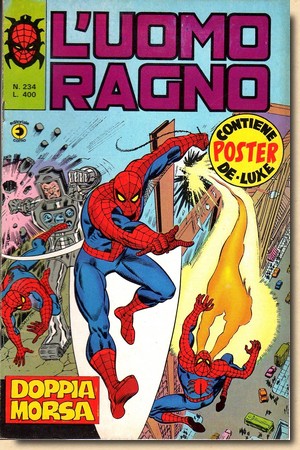 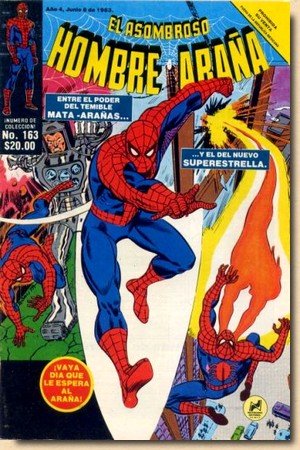 |
| |
| |
| NOTES [1] "Profile on Neil Tennant", petshopboys.net
|
| |
|
| |

|
| |
Uploaded
to the web 20 July 2016
|


|
|

































